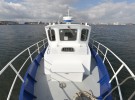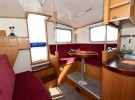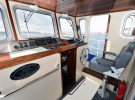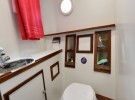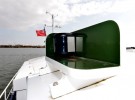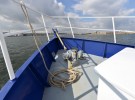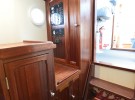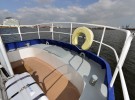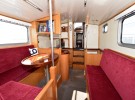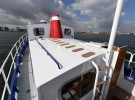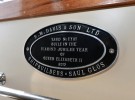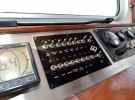Nick Burnham takes to the water in the Tug Yacht 33 Union Jack, a ‘quirky motorboat from Gloucestershire’
One of the many pleasures of this job is meeting hugely interesting and divergent characters: and greeting me at the very agreeable surroundings of Penarth Marina are two gentlemen whose individual characters are worth getting to know as, between them, they encapsulate exactly what this splendid little ship is all about, writes Nick Burnham.
Alan Keef is the owner of Union Jack, a Tug Yacht 33. A light railway engineer, his company builds narrow-gauge railways and bespoke locomotives and carriages.
He describes it with a smile as a ‘hobby that got out of control’. Whether you’d like a ride-on for your leisure park or an industrial railway for your quarry, Alan is your man. He has even put a railway on a huge commercial ship!
Talking of ships, Alan also once owned a share in a 1,000-tonne coaster. ‘Rich in experience if not actual money,’s how he describes commercial ship ownership.
Then there’s Craig Glassonbury. When Craig was at school he knew exactly what he wanted to do when he grew up; he wanted to build boats. So when the school organised work experience, Craig bagged himself a week at the local boatyard, RW Davis & Son.
And when the school organised a second week of work experience which was supposed to be at a completely different organisation, Craig dug his heels in and managed to get another week at the boatyard.
‘All I wanted to do was build boats,’ says Craig, ‘so there was no point going anywhere else’. A Youth Training Scheme followed, at RW Davis naturally, leading to a full-time job.
That was 28 years ago: Craig’s been there ever since and now manages the place. RW Davis is based on the Gloucester to Sharpness canal that links the River Severn to Gloucester. With about 10 staff, a dry berth, a 10-tonne crane, a machine shop and a woodworking shop, there isn’t much the yard can’t handle. ‘From keel to curtains, we can do it here,’ says Craig.
RW Davis specialises in steel boats. They’ve built canal boats, barges, replica working narrowboats, butties and passenger ferries. ‘Anything we like the look of,’ is how Craig describes it.
Alan laughs. ‘He’s not joking: when I went in there with plans for my Tug Yacht to enquire about costs to build it, the kettle went on and the enthusiasm was such that I had to let them build it even if I’d changed my mind!’
The plans were bought from Californian company Glen-L.
Having owned motor-sailers in the past (a steel 30-footer and a Fairey Fisherman built out of hot-moulded mahogany), Alan had been toying with the idea of moving to pure motor in order make life afloat a little easier as he crept toward later years, and bought the designs 15 years ago in 2000. Work started in 2012, and the boat launched two years later in 2014.
The real deal
Alan’s brief was to build him ‘a proper little ship’, and that is exactly what he got. It’s a term that gets bandied about a lot for anything small and solid, but this is the real deal. Built from mill-certified British steel, 5mm thick to the chine and 4mm above, it sits squarely on the water exactly like a commercial tug, complete with high stem and gunwales that sweep down and aft to the pert transom with its boarding steps that are cleverly replicated either side of the rudder to allow someone in the water to gain access back on board.
That rudder is linked to the long central keel, encapsulating and protecting the propeller. Twin bilge keels allow the craft to take the ground upright, albeit at a bow-down attitude. At deck level, deep bulwarks are topped by guardrails that are almost waist-high, protecting massively wide side decks. Those rails, although painted, are actually stainless steel so that they won’t rust if the paint is chipped or scratched. Fairleads through the bulwarks are similarly stainless steel-rimmed for the same reason.
The original plans suggested a wooden superstructure, but Alan and Craig agreed that making the whole ship out of steel made far more sense. The profile is entirely sympathetic to the tug style, with a raised pilothouse and forward- sloping windscreens. There’s even a proper working funnel (emblazoned with Alan’s company ‘K’ symbol, one of several dotted around the boat): the exhaust is fed upwards through it rather than exiting the transom as normal.
It also provides stowage for gas bottles, keeping them up out of the way, allowing them to vent easily overboard and keeping the gas pipework to a minimum (the galley is directly beneath it). Up forward, the manual rather than electric winch is a deliberate choice by Alan, who once accidentally
stood on the ‘winch in’ button of a previous boat while his hand was on the chain…
Improved lines
Back aft there’s a small cockpit well with a curved bench seat that matches the sweep of the transom. In fact there were two transom options, this rather more sculptured offering or a completely flat truncation of the hull. The latter, Craig and Alan felt, looked rather like someone had run out of money in build and simply stopped dead.
A few other changes were made to the initial designs. The boat is actually slightly longer than the original 9.4m (31ft) plan, much of which has gone into providing a larger pilothouse, itself set a little further back than originally intended to improve the lines.
‘This is a real benefit of working with steel,’ says the evangelical Craig. ‘You’re not stuck with you can build whatever you like!’ I’m put in mind of Jack Rolfe, fictitious owner of the Mermaid Yard in the BBC’s Howards’ Way – ‘I’m not building bluddy toy plastic boats in my yard, and that’s final!’ Certainly the Tug Yacht 33 is no toy.
Cabin access is via doors either side of the wheelhouse or bi-opening doors and a sliding hatch from the cockpit into the aft saloon. Mind your head as you access via the latter option and you find yourself in the snug yet spacious saloon, well lit by large Houdini windows.
There’s a comfy dinette to port – an oval table featuring another of Alan’s ‘K’ motifs and a settee to starboard, the backrest of which lifts to create two occasional pullman berths. The two levers just inside the door to starboard are repeat throttle and shift levers – should you ever need to use the emergency tiller they allow you to control the engine from the cockpit as well.
Ahead to port is a decent-sized, U-shaped galley complete with an oven and grill to go with the two-burner hob, and a small bar area lives opposite to starboard, housing the fridge. Three chunky steps take you up to the pilothouse: this is where it really feels like a little ship.
The helm is to starboard ahead of a pedestal- mounted captain’s chair and there is further seating to port for crew to enjoy the elevated views through the 8mm-thick windscreens under way. Head forward and down and you’ll find a roomy heads to port, a shower pulling out of the faucet and the electrics panels and stowage opposite.
A vee-berthed cabin in the bow completes the layout. The whole interior is lined in sapele (a mahogany substitute) and oak, giving a traditional feel entirely in keeping with the style of the craft.
Easily accessible
A Beta engine was chosen for a couple of good reasons. They’re made in Britain which, given that it’s a British-built boat made out of British steel and called Union Jack, fits rather well. And, more geographically precisely, Beta is rather conveniently based in Gloucestershire, just five miles from RW Davis.
Fitted beneath the pilothouse floor, it’s easily accessible by lifting a couple of floor panels and there is plenty of room to get down and around it. Its 3.6 litres spread over four naturally aspirated cylinders and 75hp swing a 24in propeller to give the Tug Yacht about 71⁄2 knots flat out, but before we can test it we need to wriggle free of the confines of Penarth Marina.
A single shaft drive doesn’t give many options compared to a pointable sterndrive or the leverage of twins, but 10 tonnes of displacement and those bilge keels make it a docile and predictable companion. Certainly a bow thruster would be a benefit in tight berthing situations, but it’s not essential.
In company with Craig’s wonderful converted 1930s Liverpool class lifeboat (along for photography duties, surely the safest photo boat I’ve ever had the use of) we slip through the lock into the calm open water of a still day. With the side doors open there’s plenty of light and ventilation, augmented by the large windscreens and overhead hatches. Only the view aft is slightly compromised by the central funnel positioned just behind it flanked by two small windows, but it’s perfectly workable should you need to check what’s coming up astern before changing course.
Pinning the throttle to the end stop sees the GPS (part of a fairly impressive armoury of navigation equipment Alan has specified for Union Jack) eventually peak at 71⁄2 knots, the tachometer showing 2,750rpm. Drop the revs back to 2,000rpm and you find the cruising sweet spot of about 6 knots, the boat feeling every inch the ‘little ship’ – absolutely rock-steady.
Related articles
- Tips and tricks for sailing on rivers
- Anchoring: 6 Tips for tricky situations
- 5 Hand-bearing pilotage tips
- Bermudan rig vs Junk rig
- PBO Sail Clinic: free hands-on expert advice for readers
With the dry exhaust exiting through that funnel just aft of the pilothouse noise levels are a touch more intrusive that one might like. Interestingly, my sound meter read 74dB(A) which isn’t that loud, showing that perception is as much about tone as volume. It’s the price you pay for a ‘proper’ dry exhaust: routing waste engine gases through a more traditional wet exhaust would eradicate the issue if it were a concern.
Beta claim a consumption of about 8lt an hour which, given the Tug Yacht’s 800lt fuel capacity, makes the maths easy – 100 hours which, at 6 knots cruise, gives about 600NM until dry, or 500 with a 100-mile safety margin. Of course, in reality you don’t start your engine and immediately run at cruising speed until you shut down, so for some real-world figures Alan has calculated that over the 130 running hours he’s completed since launch he has averaged 2.926lt an hour (calculated to three decimal places: can you tell he’s an engineer?).
What’s more interesting is that he couldn’t give me that figure until a few days after the test because those large tanks meant that, despite a year of use, at that point he hadn’t actually filled up since he bought it! Suffice to say that running the Tug Yacht is unlikely to break the bank.
PBO verdict
The Tug Yacht comes as a real breath of fresh air against the backdrop of excellent but anodyne mass-production fare I often get to test. Conceiving a boat from a set of $300 plans from California and commissioning a small boatyard in Gloucester to build it might seem like a brave leap of faith until you meet the two men involved; the owner with his keen engineering understanding, and the builder with his obvious passion and dedication for boatbuilding.
Certainly it has paid off for them both. Alan is smitten with his Tug Yacht, a genuine ‘little ship’ that fits his way of life perfectly – and Craig is so pleased with how it has turned out that he wants to build more of them. If you want the last word in performance, fashion and interior design, the Tug Yacht isn’t for you.
Little sleep is being lost by the Sunseeker board of directors about this quirky motorboat from Gloucestershire. But if you fancy a proper little ship, this just might be worth serious consideration.
Tech spec – Tug Yacht 33
- Price: £175,000 inc VAT
- LOA: (hull): 10m (33ft)
- Beam: 3.5m (11ft 6in)
- Draught: 1.29m (4ft 3in)
- Displacement (approx): 10 tonnes F
- Fuel capacity: 800lt
- Builder: RW Davis & Son Ltd,
- Tel: 01452 740233
- www.rwdavis.co.uk
About the author
After 20 years as a yacht broker, Nick Burnham embarked on a marine media career, quickly rising to the position of boat test editor for Motor Boats Monthly. Nick is now a freelance writer and photographer covering all things nautical.




